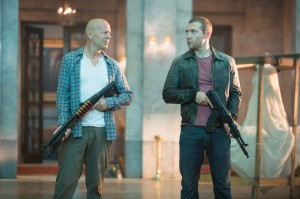Die Hard delivers fast-paced action, lacks substance
It’s odd to think that the Die Hard franchise started with a film based on a script that was an unofficial sequel to Frank Sinatra’s The Detective. The movie was passed over by Arnold Schwarzenegger and Sylvester Stallone and instead starred an actor who at the time was mostly known for his role on a cop dramedy on ABC. For a film with such an odd background, it would turn the character of John McClane into one of the staples of the action genre and turn Bruce Willis into the quintessential, everyman action star.

Guys and guns · John McClane (Bruce Willis) reconnects with his estranged son Jack (Jai Courtney) to join forces and stop a nuclear weapons heist. The narrative of their relationship is one of the film’s strongest points. – Courtesy of Frank Masi
A Good Day to Die Hard certainly has the right attitude and keeps the action at a brisk pace, but the question to ask yourself going into it — and even after seeing it — is this: What actually makes a Die Hard movie different from any other action film?
The previous film, Live Free or Die Hard, had a number of issues, the core of which had to do with the PG-13 rating that restrained the main character. It also made McClane into some sort of “super cop,” a move that diminished what was appealing about him in the first place. Despite that, the film ended up being the most successful film of the franchise, in particular with international audiences.
That being said, bringing the franchise to Russia, of all places, might seem a bit jarring for a guy like John McClane, who, despite foiling scheme after scheme, is still just a regular guy from Jersey. To suddenly be caught up in international politics is a bit much. Drawing McClane to the Motherland is the news that his son Jack (Jai Courtney), with whom John has an estranged relationship has been arrested in Moscow for shooting down an associate to Chagarin, a high-ranking but corrupt defense secretary.
In typical McClane fashion, however, John arrives just as Jack is escaping with Yuri Komarov (Sebastian Koch), a political prisoner who might hold information that could take down Chagarin and the Russian military complex. As it turns out, Jack is actually an agent working with the CIA who wants to obtain the information that Komarov has. John’s arrival sabotages the entire operation and puts father and son on the run and on their own in enemy territory — not exactly the family reunion either one was expecting.
Things proceed in the expected fashion, with John being the delightful prick that he’s always been. The film also incorporates the classic details that fans have come to expect — elaborate and destructive set pieces, the banter between the two McClanes, the big twist in the third act, and the now-legendary Yippie-Ki-Yay catchphrase that has been featured in every Die Hard.
So going back to the initial question: What makes a Die Hard movie different from other action films, and does this film accomplish that distinction? If you go back to the ’80s, the action genre was mostly dominated by giant supermen like Schwarzenegger or ridiculously fit specimens like Jean-Claude van Damme. However, McClane was just a regular guy. He cursed, made mistakes, got angry, had a troubled marriage back home and was just a person that always found himself in the wrong place at the wrong time.
So does this film achieve that McClane touch? In a way it does, but not entirely. The film is very short, running about 97 minutes, which is a good half-hour shorter than the previous entry. At times, it feels more like a montage or a “best of” album. It definitely hits the mark, but in a clinical sort of way — like that of a person completing a checklist.
One good aspect of the film is that the pace of the action is very visceral and raw, particularly the ridiculous car-chase scene throughout Moscow. And the relationship between John and his son holds the film together, even though, with the limited runtime, we don’t really know what compelled him to not only cut off communication with his dad, but also his mom and his sister Lucy (Mary Elizabeth Winstead).
Courtney keeps up nicely with Willis, who seems much more invested in this installment than in the fourth one. He seems to have found the right mix between brawn and snippy. It’s interesting that the producers were initially looking at someone like Aaron Paul, who plays Jesse Pinkman in Breaking Bad, for the part of Jack, but decided to go with Courtney since he’s a lot more believable as a CIA-trained combatant than Paul would’ve been.
Without spoiling anything, the antagonists, or at least the real ones, aren’t what you would consider memorable, which is a shame considering the best Die Hard film — the first and third installments — have the best villains. There’s no one like Hans Gruber in this feature, which is a shame.
So is this film any good? Depends what you’re looking for. If you’re looking for a quick, visceral action-packed flick for President’s Day weekend, then this film accomplishes that nicely. But strictly as a Die Hard film, it certainly gets everything you’d expect out of one but that’s about as far as it goes.
It’s like watching a band from the 1980s: great job for still rocking, but you only like the band for its old songs and none of its new ones.
